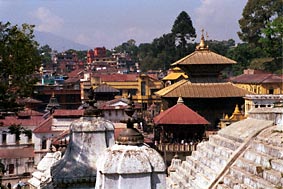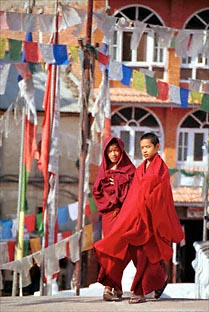
Kathmandu, page 4 of 4

The Bagmati is as said before a holy river, just
as the Ganges in India. People are cremated at the riverside in Pashupatinath like in Varanasi. In Varanasi we saw also burning
places, but we didn’t came close and certainly we didn’t smell anything. Here in
Pashupatinath the confrontation with the practice of burning of bodies is much more
shocking, it is only a small place so everything is scaled down. We met a woman on the
street who was crying terribly,  out in the open like we would never do. Everywhere around people
were merry, the atmosphere around Hindu temples is often very festive. A lot of stands are
offering souvenirs again. This all happens quite close to the burning. Imagine how
European or American people burying a dead relative would react, when on the same cemetery
another family would have a not too quiet birthday celebration!
out in the open like we would never do. Everywhere around people
were merry, the atmosphere around Hindu temples is often very festive. A lot of stands are
offering souvenirs again. This all happens quite close to the burning. Imagine how
European or American people burying a dead relative would react, when on the same cemetery
another family would have a not too quiet birthday celebration!
So life goes on and defying the horrible smoke we
went looking for the Bachhareshwari temple, again a temple with erotic carvings according
our LP. It wasn’t easy to find the temple, because the buildings around it were used
to live in. Laundry was hanging in between some pillars and chickens, pigs, children and
bison's walked freely around in the temple court. This is absolutely not unusual in Nepal,
but we didn’t want to nose about too much, so we doubted a bit if we could enter. No
tourist to be seen, although  it was crowded with foreigners only 100 meter away.
it was crowded with foreigners only 100 meter away.
When nobody reacted on our presence our curiosity won over our prudence and we looked at the temples. This were again very old ones, obviously neglected for many years, with the exception of the erotic carvings. Apparently a very religious person takes the trouble to paint the erotic carvings at critical places afresh with red paint once in a while! The effect is a bit obscene, but I decided to show it anyway on this page to give you a more complete overview of all different carvings that are to be found in the Kathmandu Valley! To complete your information about this temple: the LP states that in the old times even human sacrifices took place in this temple. Close to the dark temple with its pagan carvings and with the stench of the burning in my nose I don’t find this very difficult to imagine.
From Pashupatinath we walk to Bodnath, a nice not too tiring walk that brings us first uphill to the
Goraknath temple complex. Jungle would be a better name, because both temples and
trees/plants seem to grow everywhere! I made a picture of a big ‘lingam’, a
phallic symbol of the creative powers of Shiva. It is very stylized and you need quite a
dirty mind to see something phallic in it (no problem for me), some of the pictures on
this page are a lot easier to interpret! Furthermore below is a picture of the bull Nandi,
the ‘vehicle’ of Shiva, covered with orange and red paint by some contemporary
artist.
a nice not too tiring walk that brings us first uphill to the
Goraknath temple complex. Jungle would be a better name, because both temples and
trees/plants seem to grow everywhere! I made a picture of a big ‘lingam’, a
phallic symbol of the creative powers of Shiva. It is very stylized and you need quite a
dirty mind to see something phallic in it (no problem for me), some of the pictures on
this page are a lot easier to interpret! Furthermore below is a picture of the bull Nandi,
the ‘vehicle’ of Shiva, covered with orange and red paint by some contemporary
artist.

We follow the trail downhill to the Guhyeshwari
temple, not open again to tourist as we find out when we already almost enter the temple.
A very polite Nepalese man explains to us that we are not Hindu and so can’t enter,
he seems afraid of hurting our  feelings. He asks where we come from and we talk a bit to reassure
him. I still have this smell of burning corpses hanging in my nose, it takes at least a
day to get rid of it and when I see the pictures again I smell it immediately. I hope you
didn’t catch it from watching the pictures!
feelings. He asks where we come from and we talk a bit to reassure
him. I still have this smell of burning corpses hanging in my nose, it takes at least a
day to get rid of it and when I see the pictures again I smell it immediately. I hope you
didn’t catch it from watching the pictures!
The Guhyeshwari temple is quite close once more
to the Bagmati River, which makes a big turn around the hill. We cross the river over a
bridge that is not supposed to be there according LP, so that saves us a lot of extra
walking. From here we can already see the enormous white Bodhnath Stupa, but when we walk closer by we arrive in a small village
and can’t see the Stupa anymore. Now we have a problem to decide which trail to
follow, both seem to go the wrong way! Some native sends us left, after 10 minutes walking
we get suspicious because the trail follows the river to close and ask it again, and
indeed we have to go back! This is a friendly man working in a small sewing-shop; he
leaves his shop for a moment to show us the right way, which he points out to us swaying
with an enormous pair of scissors…. 'Follow this road and do not turn left nor
right', he repeats a couple of times to make sure this foolish tourists won’t be
tempted to take a wrong turn.
closer by we arrive in a small village
and can’t see the Stupa anymore. Now we have a problem to decide which trail to
follow, both seem to go the wrong way! Some native sends us left, after 10 minutes walking
we get suspicious because the trail follows the river to close and ask it again, and
indeed we have to go back! This is a friendly man working in a small sewing-shop; he
leaves his shop for a moment to show us the right way, which he points out to us swaying
with an enormous pair of scissors…. 'Follow this road and do not turn left nor
right', he repeats a couple of times to make sure this foolish tourists won’t be
tempted to take a wrong turn.
 Of course I’m tempted to take
a wrong turn - I have this instinct for shortcuts as you know by now, but because the man
was so explicit in his directions I dare not disobey and so we arrive without any further
problems quite suddenly at the entrance of the big Stupa. You can see a picture of it on
the startup page of Kathmandu. Stupas are
totally different from anything I ever saw before and this one is huge, very impressive.
Because it is in between houses and not on top of a mountain like Swayambhunath the effect is even more
alienating. I could have arrived on another planet and wouldn’t be more surprised to
see such a building. People walk around it, but you can also climb it and walk around on a
third or half of the total height. Since the Tibetan villages in Pokhara I wanted to make
some pictures of Tibetan monks, shaven heads and clothed in a ruby red robe. Now was my
chance! In fact the young monks pose easily for tourists, but I liked to take a picture
when they were not posing. The fact that you can only walk
Of course I’m tempted to take
a wrong turn - I have this instinct for shortcuts as you know by now, but because the man
was so explicit in his directions I dare not disobey and so we arrive without any further
problems quite suddenly at the entrance of the big Stupa. You can see a picture of it on
the startup page of Kathmandu. Stupas are
totally different from anything I ever saw before and this one is huge, very impressive.
Because it is in between houses and not on top of a mountain like Swayambhunath the effect is even more
alienating. I could have arrived on another planet and wouldn’t be more surprised to
see such a building. People walk around it, but you can also climb it and walk around on a
third or half of the total height. Since the Tibetan villages in Pokhara I wanted to make
some pictures of Tibetan monks, shaven heads and clothed in a ruby red robe. Now was my
chance! In fact the young monks pose easily for tourists, but I liked to take a picture
when they were not posing. The fact that you can only walk  around
the Stupa in the direction of the sun made it difficult, the chance of meeting in a
favorable way for making a frontal picture is very much lowered (I bet you never thought
about that before!), but here I succeeded at last.
around
the Stupa in the direction of the sun made it difficult, the chance of meeting in a
favorable way for making a frontal picture is very much lowered (I bet you never thought
about that before!), but here I succeeded at last.
Our last morning we pay once again a short visit to Durbar Tole in Kathmandu, before we fly to Delhi and than back home. This time it is more agreeable, I don’t know if this has anything to do with the sun which is shining now – we are later than the first time, or if it looks different because it is our last day. We are sorry to leave, there is so much more to see and to do, we didn’t do any trekking nor rafting, there wasn’t time. Of course we want always too much, visit both the North of India and Nepal in four weeks, this leaves you only time for a short impression. But it was worthwhile, as I hope you have understood by now from the pictures and from this story! The next summer we visit Kenya!
